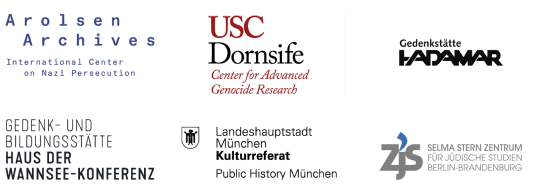Annotations
Kerpen
07/19/1942
Two cattle cars are standing on Hindenburgstraße (today Filzengraben) in the centre of the town of Kerpen. Several children watch the municipal police forcing Jewish citizens to board the cars. The ground is wet from the rain, and the girl with a hat and in Sunday clothes is carrying an umbrella.
Annotations
People
7
Keywords
4
Historical context
Deportation von Kerpen nach Minsk und Theresienstadt am 19. Juli 1942
On July 19, 1942, the Kerpen municipal police deported the last remaining Jews from Kerpen, Buir and Blatzheim to Cologne on cattle cars of the forwarder Johann Dichans. Depending on their age and health, the people were assigned either to a deportation transport bound for Minsk on July 20, 1942, or to a deportation transport bound for Theresienstadt on July 27, 1942.
After spending a night in the assembly camp at exhibition centre Cologne-Deutz, the younger people and others from the surrounding area were deported by passenger train to Wołkowysk. There they had to change train and were sent by cattle car to Minsk. While the empty passenger train was directed to Breslau to deport more people, German and Latvian SS men either shot the Rhinelander in the Blagowschtschina forest or murdered them in gas vans on the day of their arrival.
The older people were quartered in “Judenhäusern” (houses where Jews had to stay awaiting deportation) for a week before they were deported to Theresienstadt. Six of them succumbed to the fatal conditions of the ghetto there, one person, Emma Brünell, was sent to Auschwitz in 1944 and murdered there. None of the Kerpen Jews are known to have survived.
About the image series
A small-format picture showing the deportation of the last Jews from Kerpen is known today, but is available only as a modern reproduction. It shows the persecutees boarding two cattle cars belonging to the freight forwarder Dichans in front of the Gottschalk family home at Hindenburgstraße 24 (today Filzengraben), which was misused as a forced residence for Jews. The deportation was not watched by the guarding municipal police alone, but also by numerous spectators. Reports about the accurate date when the picture was taken and the deportation took place are contradictory. According to newest findings, Sunday, July 19, 1942 can be assumed to be the correct date.
Provenance
Although the origin or source of the deportation picture is unknown, its provenance can be retraced from 1988 when Kerpen resident Änne Söns handed in a print of the picture at the Kerpen town archives. It was not documented, though, how it had come into her possession. Thanks to an initiative of Peter Hövel, businessman and photographer, there is also identification information about the people in the picture preserved in the town archives. Parts of that information contradict the data provided by other contemporary witnesses, though.
Both, the negative and a contemporary small-format print, which in 1988 served as a template for reproductions that have survived to this day have disappeared.
Call number at source archive
BA_05830
Title at source archive
Deportation der letzten noch in Kerpen lebenden jüdischen Kinder, Frauen und Männer aus Kerpen am 18. Juli 1942
Acknowledgements
We would like to thank Ms Susanne Kremmer and Ms Susanne Harke-Schmidt for providing relevant information for this entry and Mr Peter Hövel for the kind correspondence.
Text and research by Lisa Paduch.
Kooperationsverbund #LastSeen. Bilder der NS-Deportationen Dr. Alina Bothe Projektleiterin
c/o Selma Stern Zentrum für Jüdische Studien Berlin-Brandenburg
Freie Universität Berlin
Habelschwerdter Allee 34A
14195 Berlin
lastseen@zedat.fu-berlin.de
Ein Kooperationsprojekt von

Gefördert durch

Datenschutz | Impressum